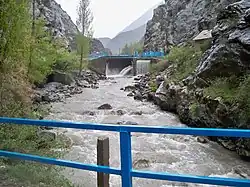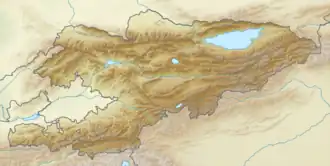Khojabakirgan
| Kozu-Baglan/Khojabakirgan River | |
|---|---|
 The Kozu-Baglan/Khojabakirgan River as seen in Katrang, Kyrgyzstan | |
 | |
| Native name | |
| Location | |
| Country | Kyrgyzstan and Tajikistan |
| Districts | Leilek, Kyrgyzstan Jabbor Rasulov and Ghafurov, Tajikistan |
| Towns/villages | Katrang, Korgon, Beshkent, Kayragach, and Qal'acha |
| Physical characteristics | |
| Source | |
| • location | Turkestan Range, Leilek District, Kyrgyzstan |
| Length | 117 km (73 mi) |
| Discharge | |
| • average | 10.3 m3/s (360 cu ft/s) |
| Basin features | |
| Progression | Syr Darya→ North Aral Sea |
The Khojabakirgan (Tajik: Хочабакиргон; Uzbek: Xoʻjabaqirgʻon/Xoʻjabaqirgan), called the Kozu-Baglan (Kyrgyz: Козу-Баглан) in its upper reaches in Kyrgyzstan, is a left tributary of the Syr Darya that flows from Kyrgyzstan into Tajikistan.[1]
A 2023 study found the Kozu-Baglan/Khojabakirgan Watershed to be the most "water-stressed" transboundary watershed in the Fergana Valley.[2][3] The river has been a focal point of water-related disputes between Kyrgyzstan and Tajikistan.
Name
The name xo‘jabaqirgan is commonly interpreted to mean "the place a khoja screamed." In the Uzbek Soviet Encyclopedia, it is spelled Xoʻjabaqirgan,[4] while the National Encyclopedia of Uzbekistan uses the spelling Xoʻjabaqirgʻon,[5] which reflects older forms of Uzbek orthography. In English-language sources, the river's name appears in various forms, including Khojabakirgan, Khoja-Bakirgan, Khojabakirghan, and Khojabakirgansai.[2][6][3][1]
In Kyrgyzstan, the river is known as Kozu-Baglan in its upper reaches, particularly among Kyrgyz-speaking communities. Further downstream, Uzbeks refer to the river as Khojabakirgan. Soviet-era sources, including those published in the Kyrgyz SSR, consistently used the name Khojabakirgan.[7] The river was officially renamed Kozo-Baglan in Kyrgyzstan following independence.
Course
The Khojabakirgan River originates on the northern slopes of the Turkestan Range in Leilek District, Batken Region, Kyrgyzstan. It initially flows in a predominantly northeasterly direction through the foothills before turning north and then northwest. Upon reaching the border with Tajikistan, the river disperses into a network of irrigation canals, with a significant portion of its flow diverted into the Great Fergana Canal. The main river channel continues northwest, passing near the cities of Chkalov and Khujand, before emptying into the southern bank of the Syr Darya.
Hydrology
The Khojabakirgan is 117 km long.[4][7] It drains an area of 2,150 km2.[4][7] The mean discharge 45 km above the mouth is approximately 11 m³/s.[8]
Along with the Ak-Suu and Isfana river basins, the Ak-Suu river basin sits above the Suluytka–Batken–Nau–Isfara transboundary aquifer in the Syr Darya Basin.[9] The Khojabakirgan subbasin is prone to flash floods.
Transboundary disputes
The Khojabakirgan River has been a source of tension between Kyrgyzstan and Tajikistan. In 2021, Kyrgyzstan announced plans to construct a reservoir on the river, prompting an immediate objection from Tajikistan. Tajik authorities argued that the project would violate existing bilateral agreements and that Kyrgyzstan was obligated to consult with Tajikistan before undertaking such developments.[10]
The sharing of the river's water is governed by a 1962 agreement signed between the Kyrgyz and Tajik Soviet Socialist Republics, which allocated 79 percent of the river’s annual flow to Tajikistan and 21 percent to Kyrgyzstan.[1][11] In 2020, Kyrgyzstan announced that it had allocated funds to build a pipeline to divert water from the river to the border village of Maksat.[12]
References
- ^ a b c Stucker, Dominic; Kazbekov, Jusipbek; Yakubov, Murat; Wegerich, Kai (August 2012). "Climate Change in a Small Transboundary Tributary of the Syr Darya Calls for Effective Cooperation and Adaptation". Mountain Research and Development. 32 (3): 275–285. doi:10.1659/MRD-JOURNAL-D-11-00127.1.
- ^ a b "Kozu-Baglan Watershed: Watershed Profile. Kyrgyzstan – Batken Region – Leylek District" (PDF). IMPACT Initiatives. Acted, International Alert, and IMPACT. Retrieved 14 July 2025.
- ^ a b "Khojabakirgan Watershed: Watershed Profile. Tajikistan – Sughd Region – B. Gafurov & J. Rasulov District" (PDF). IMPACT Initiatives. Acted, International Alert, and IMPACT. Retrieved 14 July 2025.
- ^ a b c "KHŬZHABAQIRGAN". Ŭzbek sovet ėnt͡siklopedii͡asi (in Uzbek). Vol. 12. Tashkent: Ŭzbek sovet ėnt͡siklopedii͡asi Bosh redakt͡sii͡asi. 1979. p. 413.
- ^ "KHŬZHABAQIRḠON". Ŭzbekiston milliy ėnt͡siklopedii͡asi (in Uzbek). Vol. 9. Tashkent: Ŭzbekiston milliy ėnt͡siklopedii͡asi Bosh redakt͡sii͡asi. 2005.
- ^ "Establishment of the Khoja-Bakirgan Main Canal Water User Union (KBMC-WUU)". CAWater Info. Retrieved 31 July 2025.
- ^ a b c "KODZhO-BAKYRGAN". Oshskai͡a oblatsʹ. Ėnt͡siklopedii͡a (in Russian). Frunze: Glavnai͡a redakt͡sii͡a Kirgizskoĭ sovetskoĭ ėnt͡siklopedii. 1987. p. 271.
- ^ "Таблица 2 - Воды - Природа - О Кыргызстане - Добро пожаловать в Кыргызстан!". 2022-08-16. Archived from the original on 2022-08-16. Retrieved 2023-09-26.
- ^ Second Assessment of Transboundary Rivers, Lakes and Groundwaters. United Nations. 2011. pp. 131–164. ISBN 978-92-1-054995-0. Retrieved 15 July 2025.
- ^ Dhuraev, Khalim; Nadirov, Bakhmaner (27 April 2021). "Источник в администрации Согда: «Если Кыргызстан хочет довести приграничные конфликты до водных, у Таджикистана есть достойный ответ»". ASIA-Plus (in Russian). Retrieved 14 July 2025.
- ^ "Otchetnostʹ po globalʹnomu t͡selevomu pokazateli͡u T͡SUR 6.5.2. TIPOVAI͡A FORMA dli͡a vtorogo t͡sikla otchetnosti" (PDF). UNECE (in Russian). Retrieved 14 July 2025.
- ^ "Правительство выделило средства на строительство водопропускной трубы в селе Максат Лейлекского района Баткенской области". Cabinet of Ministers of the Kyrgyz Republic. 11 November 2020. Retrieved 14 July 2025.
External links
- Kozu-Baglan Watershed: Watershed Profile. Kyrgyzstan – Batken Region – Leylek District, Acted, International Alert, and IMPACT
- Khojabakirgan Watershed: Watershed Profile. Tajikistan – Sughd Region – B. Gafurov & J. Rasulov District, Acted, International Alert, and IMPACT